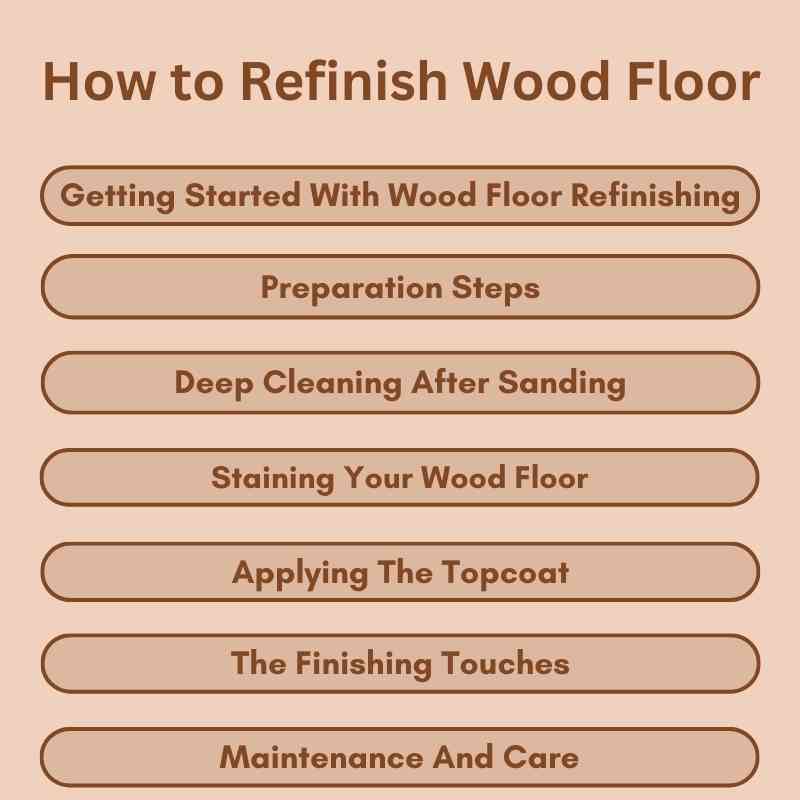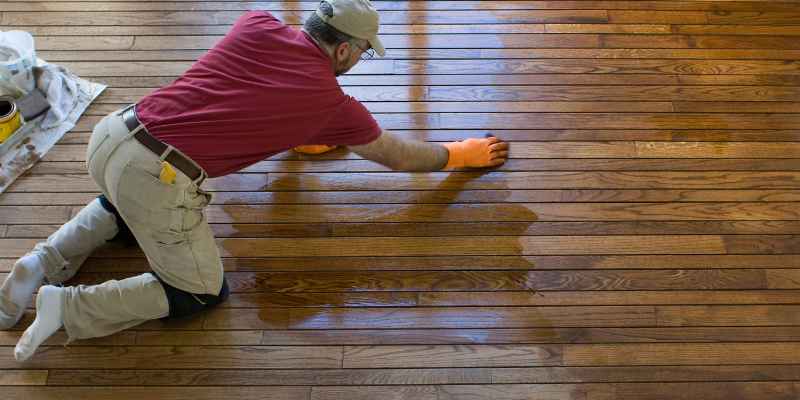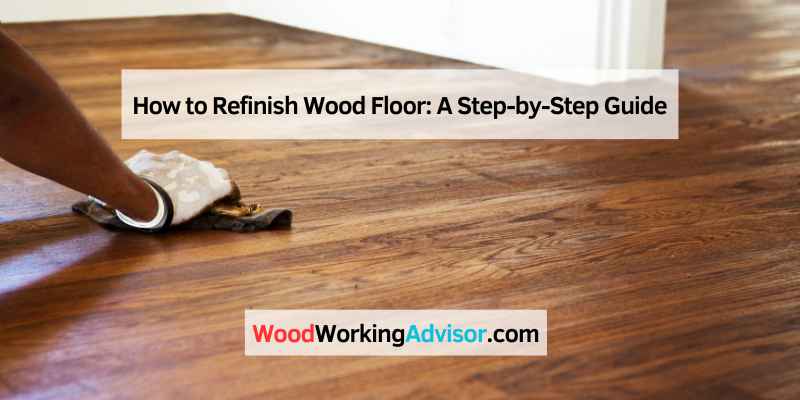To refinish a wood floor, start by sanding the surface to remove the old finish. Next, clean the dust thoroughly before applying a new stain and topcoat.
Refinishing wood floors can breathe new life into your home, enhancing both beauty and value. Over time, floors can become scratched, dull, or discolored. By refinishing, you restore their original luster and extend their lifespan. This process involves several key steps: sanding, cleaning, staining, and sealing.
Each step is crucial for achieving a professional finish. Whether you’re a DIY enthusiast or considering hiring a professional, understanding the refinishing process can help you make informed decisions. With the right tools and techniques, you can transform your worn-out wood floors into stunning focal points of your space.
Getting Started With Wood Floor Refinishing
To determine if your wood floor can be refinished, check its condition. Look for deep scratches, gouges, or discoloration. If your floor has been sanded before, it may not be refinishable. A minimum of 1/8 inch of wood is needed for sanding. If the wear layer is too thin, refinishing may not work.
Tools and materials needed for refinishing include:
| Tool/Material | Purpose |
|---|---|
| Sander | To remove the old finish |
| Sandpaper | For smoothing the surface |
| Stain | Adds color to the wood |
| Topcoat | Protects the wood |
| Vacuum | Removes dust and debris |

Preparation Steps
Start by cleaning the floor thoroughly. Use a vacuum to remove all dust and debris. Mop the floor using a damp cloth to eliminate any sticky residue. Make sure the floor is completely dry before moving on.
Next, focus on repairing damages. Inspect the floor for scratches, dents, or loose boards. Fill in any gaps with wood filler and sand it smooth. For deeper scratches, consider using a wood stain that matches your floor.
Address any loose boards by tightening or replacing them. This ensures a smooth surface for refinishing. Always wear safety gear like gloves and a mask during this process.
Sanding The Floor
Begin by sanding the main area of the floor. Use a floor sander for this task. Move in the direction of the wood grain. Start with a coarse-grit sandpaper and gradually move to finer grits. This process helps remove old finish and smooths the surface.
Next, focus on sanding edges and corners. These areas require a hand sander or a detail sander. Carefully work around the edges to ensure a smooth transition. Pay attention to any nooks or crannies that might need extra care.
Make sure to vacuum the dust after sanding. A clean surface is crucial for the next steps. This will prepare the floor for staining and finishing.
Deep Cleaning After Sanding
After sanding, removing dust and debris is crucial. Use a vacuum with a brush attachment. This helps capture fine particles. Follow up with a damp mop to ensure no dust remains.
Pay special attention to corners and edges. These areas often trap dust. A microfiber cloth can be effective for these spots. Ensure the floor is completely dry before moving on.
Final inspection before staining is important. Check for any missed spots or imperfections. Use bright lighting to spot any remaining dust. A smooth surface leads to a better finish.
Take your time with this step. Proper cleaning and inspection ensure a beautiful result. Skipping these steps can ruin your hard work.
Staining Your Wood Floor
Choosing the right stain is crucial for your wood floor. Consider the wood type and its color. Test different stains on a small area. This helps visualize the final look.
Stains come in various shades and finishes. Oil-based stains are durable but take longer to dry. Water-based stains dry quickly and have less odor. Select the one that suits your needs.
Application techniques matter for the best results. Use a brush, roller, or cloth for even coverage. Work in sections to avoid lap marks. Always follow the manufacturer’s instructions for best outcomes.
Applying The Topcoat
Choosing the right topcoat is essential for a successful wood floor finish. There are several types of topcoats available:
| Type | Description |
|---|---|
| Polyurethane | Offers strong protection and is highly durable. |
| Water-Based | Dries quickly and has low odor. Great for indoor use. |
| Oil-Based | Provides a rich look, but takes longer to dry. |
| Varnish | Good for high-traffic areas. Very tough finish. |
For the best results, follow these application tips:
- Ensure the floor is clean and dry before applying.
- Use a high-quality brush or roller for even coverage.
- Apply thin layers to avoid bubbles or streaks.
- Allow proper drying time between coats.
- Lightly sand between coats for a smoother finish.
The Finishing Touches
Light sanding between coats is essential for a smooth finish. Use fine-grit sandpaper to avoid damage. Sanding helps remove imperfections and ensures proper adhesion. Dust off the floor thoroughly after sanding. This prevents debris from ruining the finish.
The final clean and inspection are crucial steps. Start by mopping the floor with a damp cloth. This removes any remaining dust or particles. Inspect the floor for any missed spots or imperfections. Address any areas that need attention before applying the final coat. A careful inspection ensures a beautiful and lasting finish.
Maintenance And Care
Regular maintenance keeps your wood floors looking great. Sweep or vacuum daily to remove dirt and dust. Use a damp mop weekly to clean surfaces without soaking the wood. Avoid harsh chemicals that can damage the finish.
For scratches and dents, address them promptly. Use a soft cloth to rub a matching stain into the scratch. For deeper scratches, consider using a wood filler to repair the area. Always follow up with a protective finish to seal the repair.
Place area rugs in high-traffic zones to prevent wear. Use furniture pads to minimize scratches from moving items. This simple care routine extends the life of your beautiful wood floors.

Frequently Asked Questions
What Is The Easiest Way To Refinish Wood Floors?
The easiest way to refinish wood floors involves sanding the main area and edges, cleaning thoroughly, and applying stain. Finish with a protective topcoat and light sanding. This method revitalizes your floors efficiently and enhances their appearance.
Is It Worth It To Refinish Hardwood Floors Yourself?
Refinishing hardwood floors yourself can save money and provide a sense of accomplishment. It requires time, effort, and skill. Mistakes can lead to costly repairs. Weigh your experience and the potential outcome before deciding. For beginners, hiring a professional might be more reliable.
Can Wood Floors Be Refinished Without Sanding?
Yes, wood floors can be refinished without sanding using a method called “screening. ” This involves buffing the surface and applying a new finish. It’s suitable for floors with minor wear but won’t address deep scratches or damage. Always consult a professional for best results.
Can Finished Wood Floors Be Refinished?
Yes, finished wood floors can be refinished. This process removes the old finish and restores the wood’s appearance. Sanding is typically required to ensure proper adhesion of new finishes. Regular maintenance can extend the life of your floors.
Conclusion
Refinishing your wood floor can transform your space and extend its life. By following the right steps, you ensure beautiful results. Remember to take your time and prepare adequately for each phase. With patience and effort, your hardwood floors will regain their shine and charm, enhancing your home for years to come.

